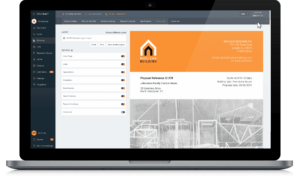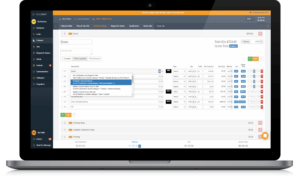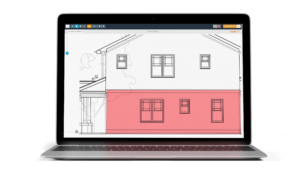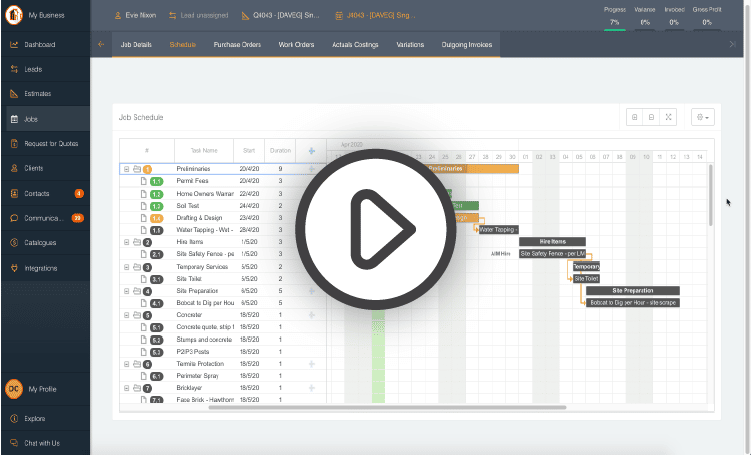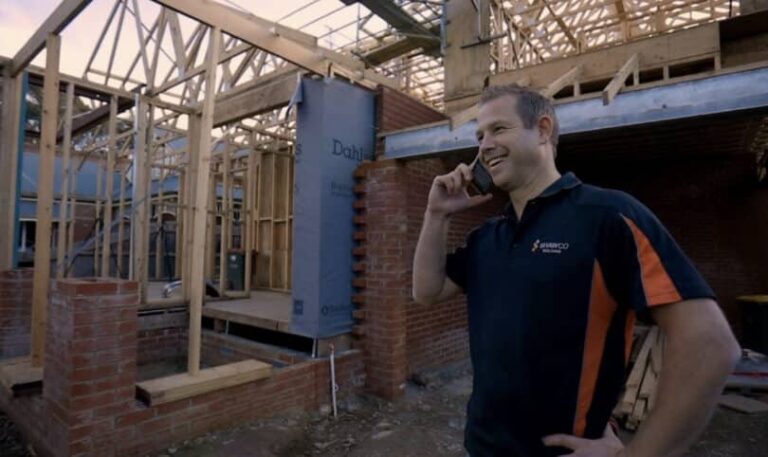If you are in the construction business — from residential to commercial and new builds to renovating — managing large or small jobs, you need to provide your customers with a project estimate before starting work. It is a critical component to forecast expenses and manage profitability. An accurate estimate also plays a crucial role in winning business.
What is estimating in construction?
Estimating when it comes to a construction project is the process of determining the total expense per construction job, and it can be as straightforward or as complex as the job requires. To be successful as a builder or renovator, the cost estimate needs to be both highly accurate and delivered to the customer in a short timeframe. Speed, accuracy and efficiency are oftentimes a reflection of your business and can weigh on the customer’s decision-making process. There are different types of construction estimates, and it all depends on the scope of a particular construction project.
A rough definition of estimating is judging something for its worth. In construction terms, construction cost estimating judges the costs (and there are many to consider) for a particular project with many decisions between the start and end of construction.
While there are different types of estimating systems, a builder or renovator will generally rely on the following construction estimating process:
1. Scopes of work
Defining the construction job. It may come from various sources like architects or engineers, walking or touring the job site, or talking to the customer to get a better sense of the construction work before preparing any construction estimates.
2. Takeoffs
These are processes to quantify the project or converting the scope to quantities. This is when the custom home builder determines how much of each material they need to complete a job. It is also sometimes called a quantity takeoff or material takeoff. This is an important part of the construction estimation process and you will want to be as thorough and detailed as possible. An accurate cost estimate should take into consideration material costs labor costs, supervision costs, among other things. It is important to be thorough to ensure the estimate ends up matching the actual costs at the end of construction projects.
Most custom home builders will tell you estimating construction projects is one of the most complicated and time-consuming tasks in the construction process. But, Buildxact makes construction estimating a very simple task. The software helps builders calculate cost estimates quickly and easily. It serves as a construction cost estimator that does all the heavy lifting for you, making the cost estimation process a very simple one.
3. Estimating Process
Here are some tips for ensuring accuracy on your material takeoffs:
a. Use a checklist
Develop a checklist of usual bid items that are included in most of your projects. This helps ensure that key items aren’t missed when bidding a project. General conditions, rental equipment, and other miscellaneous materials are often forgotten if they aren’t on a checklist.
b. Automate as much as possible
Some takeoff software allows you to capture assemblies or packages (at Buildxact we call them recipes) that are a collection of materials used as a unit in the project. An example would be an interior framed drywall wall with wooden studs at 16 inches on center. The package for this wall would include drywall, screws, insulation, wood, and nails.
By using recipes, you don’t have to calculate how many studs are in the wall, because the program calculates that for you. You just measure the wall length, and the software tells you how many studs you’ll need. This saves you lots of time!
Estimated schedule
Next, you’ll put together an estimated schedule for the project based on your scope of work. This lets you know how long the work will take and how much labor to include in your cost estimate.
The schedule should be based on the amount of material you have to install and the production rate of your employees or crews. Be sure to include crew time, supervision, and administration time in your estimate of the duration of the project. Record the trades and manhours that will be needed to complete the project.
Pricing the work
Now that you’ve got a full list of the materials needed and know how much labor you’ll need for the project, it’s time to put together your cost estimate. Cost estimates are based on material pricing, current labor rates, past projects, and your company’s experience with similar work.
First, you’ll want to make sure that your material pricing is up-to-date, especially in today’s market. Also, check to make sure the material will be available within the timeframe the project is scheduled for. In Buildxact, you can upload your own pricelist, or sync up your supplier’s pricelist with our new integration.
Your labor billing rates need to be high enough to cover wages and burden, which includes employer-paid taxes, retirement funds, vacation time, sick time, etc.
Include an allowance for overhead costs that need to be covered by the project. Overhead costs include vehicles, insurance, cell phones, computers, and office administration expenses.
Finally, add a percentage for profit, which will vary depending on how aggressive you want to be on your estimate and what the market will bear. Make sure that you correctly add up all the costs and markup, including profit, to determine your final price.
Get better bids with estimating software
You can perform accurate construction project estimates faster and easier when using estimating software. Digital takeoffs and pricing integrations improve accuracy and ensure consistent pricing across projects.
Buildxact is easy-to-use construction management software that allows you to be more efficient and price more work.
The purpose of cost estimating in construction
Cost estimates protect the builder and help manage their business. It also ensures the customer is not overpaying for a project and knows what to expect from a cost standpoint. There are a variety of direct and indirect costs associated with a construction job of any size.
- Direct costs: Linked to the physical part of the construction project and include material, labour – your staff and subcontractors – and any necessary equipment rentals.
- Indirect costs: General overhead costs such as insurance, professional services, temporary job facilities, and contingencies.
Cost estimates are a vital tool for managing the project’s performance against direct and indirect costs and using it as a template for similar projects. The more estimates you create, the faster and easier it will become.

What is estimating software?
In general, estimating software automates the formulas you use manually or on a spreadsheet into a streamlined online process. It offers reliability, accuracy, accessibility, and efficiency.
Most small builders create their estimates and do not have professional estimating staff. It is a rote process and is completed manually, with spreadsheets like Excel, while some will use a specialist software platform. Moving your business to a software platform is not complicated and you will be wondering why you did not do it sooner.
The benefits of using estimating software
Today’s construction-focused software solutions offer more than estimating since the estimate is intrinsically linked to the project; the work schedule, purchasing, subcontractor bids, customer invoicing, and reconciliation with accounts.
Most estimating software solutions help you do your job better by allowing the user to:
- Prepare custom templates for letterhead, proposals, and reports
- Create estimates from takeoffs
- Track costs and
- Integrate with accounting software
Modern software is cloud-based, which offers a range of benefits to builders and renovators. Access from anywhere, on the road or at the office, month by month subscriptions rather than big upfront investments, and the ability to easily include staff and contractors in bidding workflow. In today’s climate and remote work environment, moving your business to a cloud-based software solution will help you be more responsive and efficient with new opportunities so that you can win more business. It also helps you meet or exceed your customers’ expectations with faster, more accurate estimating.
The Buildxact Advantage
There are several estimating software systems on the market today, and many specific to the residential construction industry like Buildxact. Designed for the small builder, renovators, and various tradies, Buildxact offers an easy-to-use construction estimating software, as an integral part of an affordable construction management platform.
You can create accurate estimates in a fraction of the time with complete on-screen takeoffs using your own supplier price files, which can be easily uploaded from Excel. You can create a professional-looking quote, including specifications and images, with just a few clicks. Need to make a change? Copy the estimate, rename it, and make your changes. Our system allows you to modify and save multiple versions of estimates for a single job.
You can also store customer information and documents like permits, quotes from subcontractors, material items (like that modern sink your customer sent) along with photos you take onsite, and easily send them along to your customer.
To learn more about how our software can help you be more efficient and accurate in your business, book a personalized one-on-one demo today or try our 14-day no-obligation free trial.





